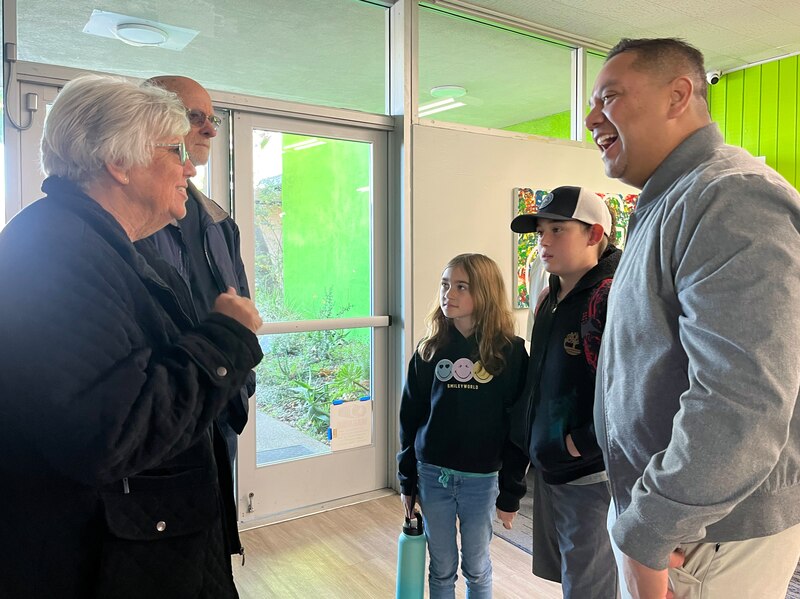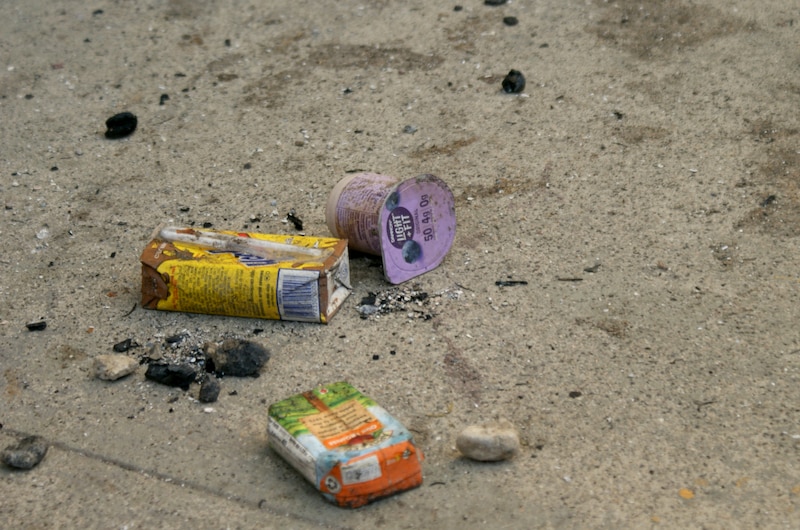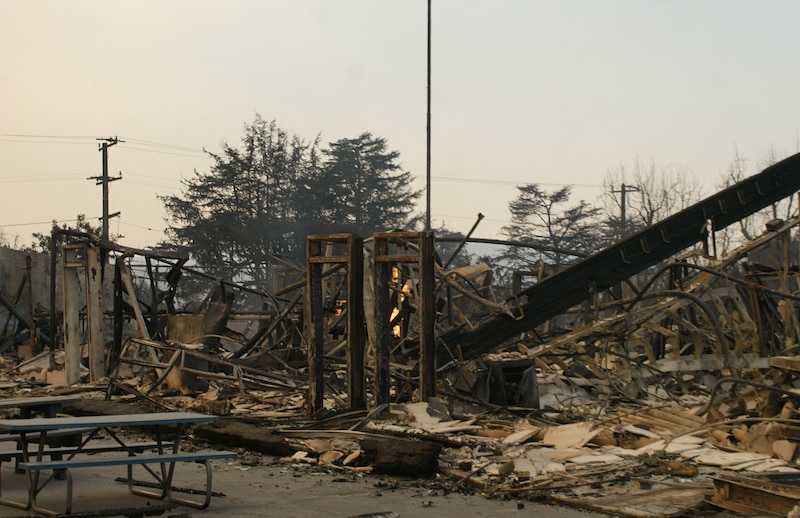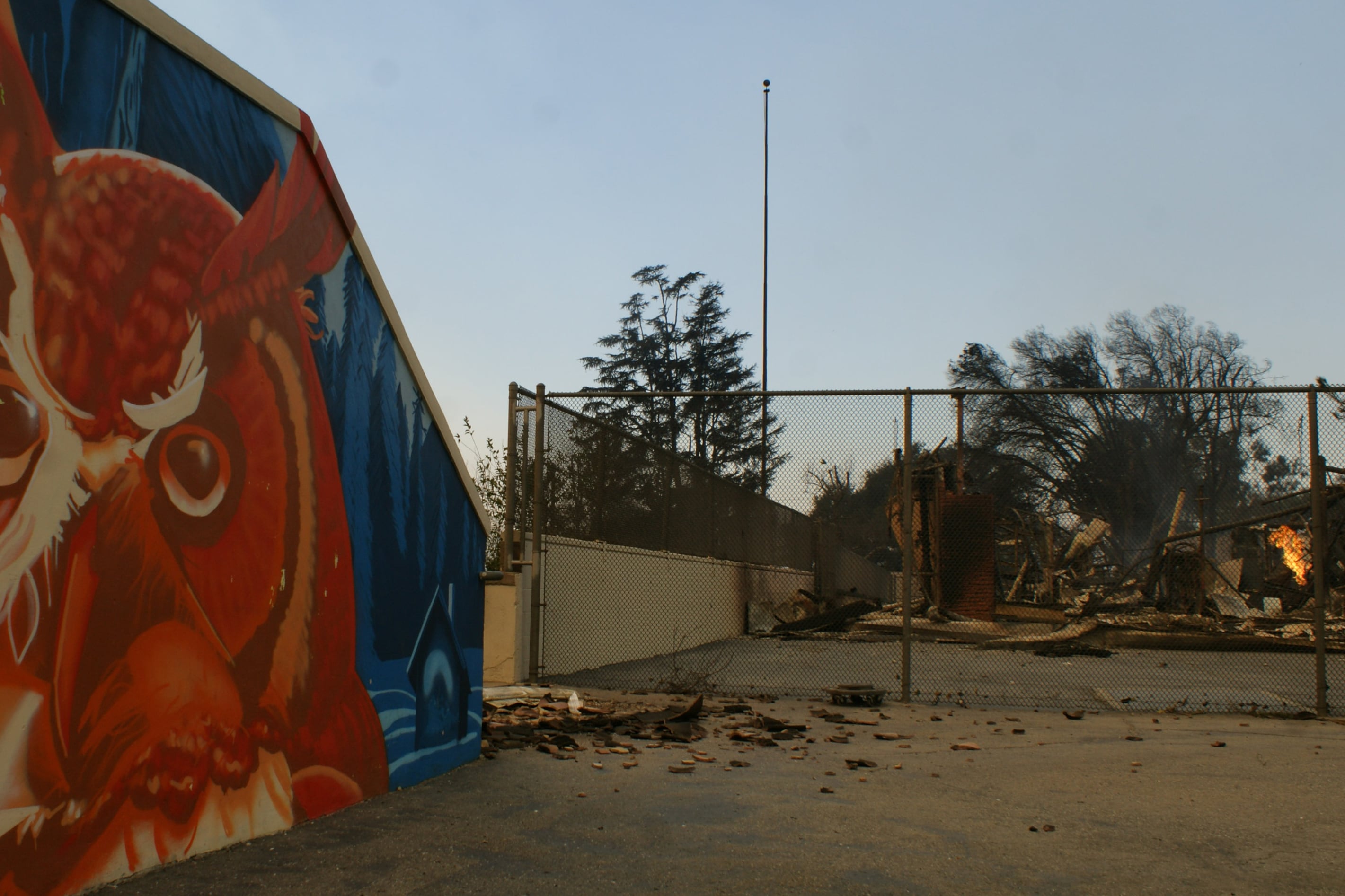Sign up for Chalkbeat’s free weekly newsletter to keep up with how education is changing across the U.S.
Carlos Garcia Saldaña drove past block after block of homes, businesses, and churches “wiped off the face of the earth.” The Eaton fire that had consumed large parts of Altadena was still burning in the San Gabriel Mountains. The charter network leader needed to see what remained of his schools.
As Garcia Saldaña approached Odyssey Charter School South, the facade and main entrance appeared intact. But as he looked left and up the hill, he saw a heap of twisted metal and charred rubble where, two days earlier, there had been classrooms, offices, lunch tables, play structures, and an after-school clubhouse. The tree stumps where students used to sit and eat and dream were still smoldering.
“It’s just jarring and heartbreaking,” Garcia Saldaña said.
Over the past week, wind-whipped wildfires reshaped wide swaths of Los Angeles, claiming at least 25 lives and destroying more than 12,000 structures. A dozen or more schools have been damaged or destroyed. The danger is not yet past, with fires only partially contained and high winds forecast through Wednesday.
Hundreds of thousands of students were out of school last week as more than 1,000 schools across 19 districts announced temporary closures due to poor air quality, shifting evacuation orders, and the many educators, school staff, and student families who had lost their homes.
On Tuesday, California Gov. Gavin Newsom issued an executive order suspending many state rules governing schools to make it easier for schools to operate in temporary buildings and for students to enroll across district lines, as well as waiving requirements about instructional days.
In the Los Angeles Unified School District, the nation’s second-largest, a handful of schools in areas still under evacuation orders, including three that were burnt in the Pacific Palisades neighborhood, remained closed early this week. The district announced that students from two ravaged Palisades elementary schools would resume classes Wednesday from other district buildings on the city’s west side.
Santa Monica-Malibu Unified opened its Santa Monica campuses on Tuesday but kept schools in Malibu closed through Wednesday due to road closures and power and gas outages. Many local families have had to evacuate because of the proximity to the Palisades Fire, and the district published a resource guide for affected families. Santa Monica-Malibu Unified also said it was monitoring air quality and that its facilities had air filtration systems in place.

In Pasadena Unified, the Eaton Fire, which started on Jan. 7, badly damaged five of its Altadena campuses, which housed a district middle school (whose student-led relief efforts went viral), a defunct elementary school, and three charters, including Odyssey South, known as OCS South. Pasadena Unified said its schools will remain closed through this week but that it will offer self-directed online learning and grab-and-go meal service.
Close-knit community faces widespread losses
Now Garcia Saldaña’s days are consumed with checking on the many families and staff who lost their homes and looking for a space where students could return to school as soon as possible.
Odyssey operates two Altadena charter schools, OCS South and Odyssey Charter, the network’s original school, which sustained minimal damage — some downed trees and smoke residue. The charter network, founded in 1999, now serves a total of 830 students in transitional kindergarten through 8th grade.
OCS South opened its doors in 2018 and relocated to its current location, on the grounds of the former Edison Elementary School, three years ago. Since then, the Odyssey community has set out to make the campus its own — painting murals, planting gardens, and replacing old play structures.
Over the weekend, Garcia Saldaña sent a video message to families describing the damage to buildings at the two campuses. Odyssey Charter will require a major clean-up; the OCS South location was a near-total loss. But Odyssey isn’t about buildings, he said in the video, but about “the community that makes us such a special and unique place that we all love so much.”
Emmanuel Barragan, a father of three OCS South students, echoed that point as he dropped off his daughter and two sons at the Boys & Girls Club of Pasadena on Monday. School leaders know the name of every single child and what they need, he said, noting, “Sometimes, it almost feels like the school is a co-parent.”
Odyssey partnered with the Boys & Girls Club to offer free child care this week. The club also alerted other local schools that its doors would be open this week to any school-age child in need of a safe place to be. The clubhouse was providing all-day programming, including arts and crafts, sports, and educational games, and waiving its drop-in fee.
More than 200 students had arrived by mid-morning on Monday. Garcia Saldaña, better known to students as Dr. Carlos, was at the door to greet Odyssey families. He offered hugs as students made their way inside, and he checked in with caregivers about their housing status.

A survey of Odyssey’s roughly 650 families had yielded more than 300 responses, with 83 student households reporting “full loss of home & belongings.” Others said they didn’t yet know the condition of their home. Four Odyssey employees, including the Odyssey Charter principal, also lost homes in the fire, Garcia Saldaña said.
Altadena native Marcellus Nunley evacuated with his family around 3:45 a.m. on Jan. 8. Within hours, their home was gone. “Everything melted” was how his 5-year-old son, an Odyssey Charter kindergartener, put it. Nunley dropped off his son at the Boys & Girls Club so he could spend the day managing the logistics of a family displaced by fire: calling the mortgage company, reaching out to the county tax assessor, and procuring all of the little life necessities he hadn’t given much thought to until they went up in flames.
The losses are exacerbated by Altadena residents’ love for their neighborhood, with its charming bungalows and craftsman homes, picturesque hiking trails, and beloved local businesses. “Altadena is a diverse community, which is wonderful. It’s a walking community, it’s a dog walking community, it’s town and country,” Nunley said. “It’s a great melting pot of society.”
Before the Eaton Fire, about 42,000 people resided in Altadena. Many Black families who faced housing discrimination in other Los Angeles neighborhoods purchased properties in Altadena in the 1960s. Today, Black residents make up about 18% of the population. Roughly a third of Altadena residents are Hispanic, about 40% are white, and there are many Asian American and biracial families.
The Odyssey student body reflects the community’s racial diversity. It’s also economically diverse, with about 30% qualifying for free or reduced-price lunch, according to Garcia Saldaña.
Caitlin Reilly’s two sons, 10-year-old Townes and 8-year-old Ellar, are students at OCS South. When the Eaton Fire forced another Odyssey family to evacuate early on Jan. 8, they drove to the house Reilly shares with her partner and kids, located in a section of Pasadena outside of an evacuation zone.

For the next four days, the four adults and four children huddled together in the two-bedroom, one-bathroom home. The kids had an epic sleepover, and the parents stared at their devices, searching for the latest news about the fires engulfing Los Angeles.
Meanwhile, Odyssey families connected on social media and text chains, offering up what they could and asking for what they needed, Reilly said. They arranged indoor playdates so kids could be together without breathing the smoke-filled air. They replaced baseball bats and gloves for Little League players who had lost theirs to fire, and they organized backpack and supply drives. The school launched a GoFundMe campaign to support recovery efforts.
Fire’s devastation leaves uncertainty about next steps
The evacuated family’s Altadena house is still standing, but their badly damaged neighborhood remained under evacuation orders this week. They secured a temporary rental, but Reilly fears that many local families who lost homes will have a hard time finding a place to stay.
“The fear is that it will be like Katrina,” she said. The 2005 hurricane devastated New Orleans, damaged or destroyed most of its school buildings, and scattered many of its residents. “We’re worried that we’ll lose so many families that are part of the community because there is nowhere to house them.”
That would hit Odyssey hard, given the closeness of its community and the fact that its funding is tied to its enrollment numbers.
“There’s been cheerleading about cleaning up and rebuilding, but as far as logistically what comes next, I don’t think anyone knows yet,” said Reilly, who serves on the Odyssey Charter Schools board.
Mary Scott, whose 10-year-old son, Charlie, attends OCS South, also fears dwindling enrollment at Odyssey. “The reality is, these aren’t all well-off families, and now they have to find a place to rent and rebuild while also having to pay their mortgages,” she said. “I do worry about the families that have to relocate. It would be a tremendous loss.”
Odyssey leadership acknowledges how much remains unknown: when schools will reopen in person, where classes will be held, how many families will stay local and how many will resettle elsewhere, and the extent to which the network will need to rely on remote learning.
Scott, for one, said she’s hoping to avoid remote learning because it was so difficult during COVID school closures when her son was in kindergarten and first grade. But if she had to choose between online schooling and leaving OCS South, she said would likely stay put because “I don’t want to abandon our community.”
Garcia Saldaña said the COVID years taught him a lot about what works for online learning (shorter lessons, movement breaks) and what doesn’t (asking kids to sit still for two to three hours at a time). But he’s mostly focused on finding a temporary physical location so students can return in person as soon as possible.
At the same time, he’s still figuring out the availability of Odyssey’s 115 employees, many of whom remain displaced, and asking teachers to reach out to each of their students.
“It’s about having a familiar voice on the other end of the line saying, ‘What do you need? How is your family?’” he said. “We are all human, first and foremost.”
Gabrielle Birkner is Chalkbeat’s features editor and fellowship director. Email her at gbirkner@chalkbeat.org.






